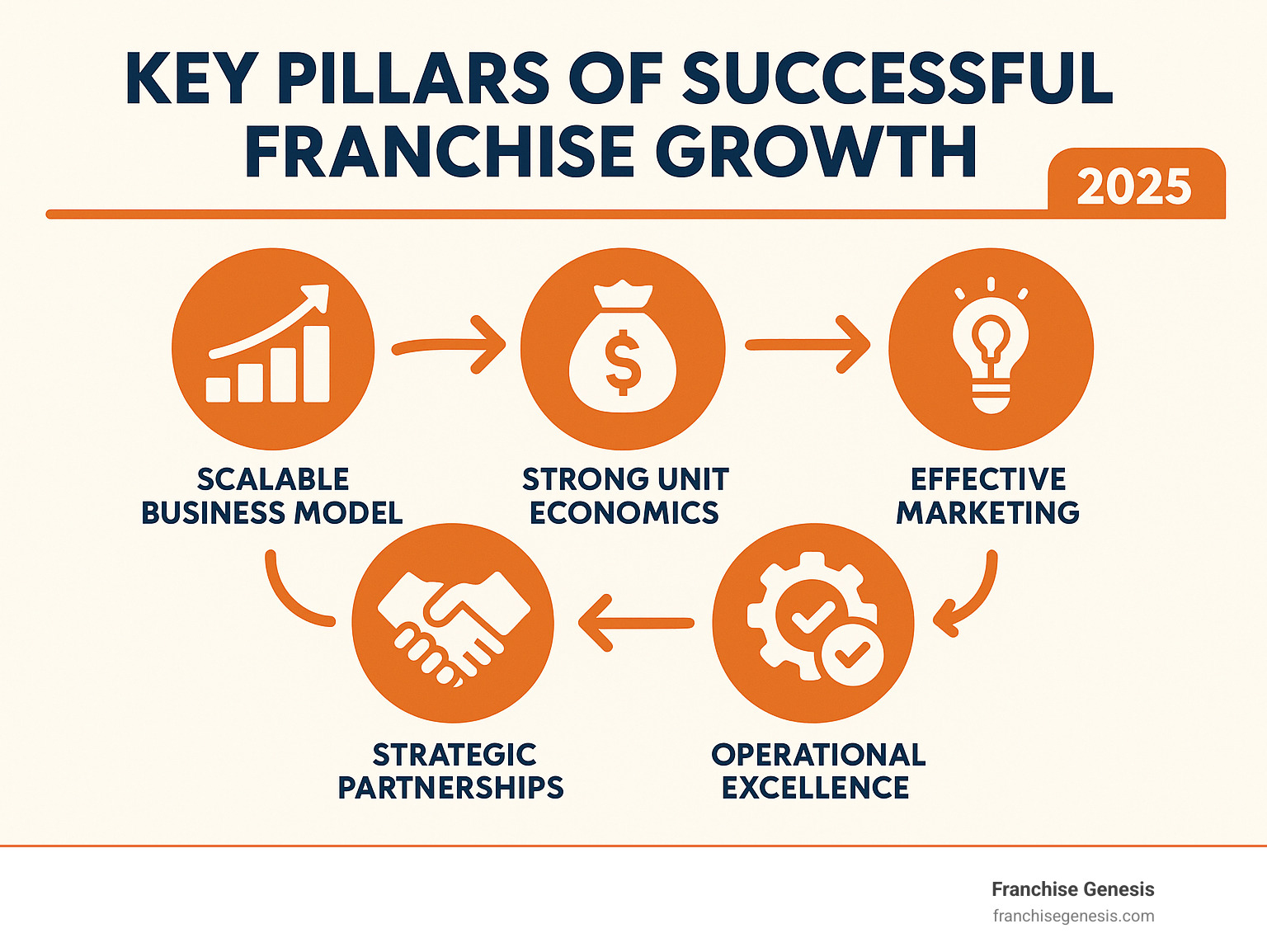The Core of Scaling Your Business Through Franchising
Franchise growth strategies are your roadmap to expanding your successful business by allowing others to open locations under your brand. They involve a clear plan to replicate your success. For businesses looking to scale, these strategies are vital for reaching new markets and increasing brand presence.
Here are the fundamental pillars of a successful franchise growth strategy:
- Scalable Business Model: Your business must be easy to replicate and profitable in many locations.
- Strong Unit Economics: Each franchise location needs to be financially sound for the franchisee.
- Effective Marketing: You need a clear plan to attract both customers and new franchisees.
- Operational Excellence: Consistent quality and efficient processes across all units are key.
- Legal & Compliance Framework: A solid legal foundation protects your brand and your franchisees.
- Strong Franchisee Relationships: Building trust and providing great support is crucial for long-term growth.
Growing a business is no small feat. It requires careful planning, smart thinking, and a crystal-clear path forward. Franchising offers a powerful way to expand, leveraging the capital and drive of others. It means your brand can reach new heights without you having to carry all the financial risk yourself.
I’m Monique Pelle-Kunkle, Vice President of Operations at Franchise Genesis. I lead franchise development and scaling, helping business owners with their franchise growth strategies and guiding them through identification, structuring, and growth phases. My experience includes scaling an ABA therapy franchise to over 100 locations in its first year, demonstrating a strong ability to coordinate growth across multiple markets.

Laying the Foundation: Is Your Business Ready to Franchise?
Before diving into franchise growth strategies, you must answer a critical question: Is your business ready to franchise? Many successful single-location owners assume they’re ready to expand, but franchising requires more than a great concept. It requires a business that someone else can run just as successfully as you do, with clear, step-by-step instructions.

Successful franchising begins with honest self-reflection. Profitability is the first checkpoint; your business must generate consistent profits to attract investors. Your brand identity must be strong enough to draw customers in new markets. The most critical element is having replicable systems. Every process, from customer greetings to complaint handling, must be documented so a new owner can achieve the same results. Finally, ensure there is customer demand beyond your local area, as what works in one town may not translate elsewhere without research.
Financial readiness is also key. You’ll need significant upfront capital for legal fees, operations manuals, and to support your first franchisees before royalty income becomes steady. If you’re questioning if franchising is right for you, our guide on Why You Should Franchise can provide clarity.
Assessing Your Business Model’s Viability
A business is scalable when profits grow faster than costs. Your franchise model’s operational blueprint must be clear and efficient enough to work across many locations without a dramatic increase in overhead.
Standardized operations are essential. Every process must be documented and repeatable. Businesses often fail at franchising because their success relies on instinct that can’t be taught. Your unique value proposition must be compelling to both new customers and potential franchisees. A SWOT analysis can help you identify your strengths and market position. For example, one client finded their rapid response time was a key differentiator, which boosted franchise inquiries by 25% when highlighted in their marketing.
The ultimate scalability test is whether your success can be replicated without your physical presence. If the business relies on your personal touch, you have more work to do before franchising.
Understanding the Financial and Legal Commitments
The financial and legal commitments of franchising are significant. Initial franchising costs often start around $250,000 to cover legal documents and marketing for your first opportunities. This is a long-term investment.
Since research shows 82% of business failures stem from cash flow issues, franchisors must have enough capital to launch and sustain the network before it becomes profitable.
The legal side is demanding. Your Franchise Disclosure Document (FDD) details your company, finances, and expectations for franchisees. Per FTC regulations, you must provide this document 14 days before any agreements are signed or money is paid. Intellectual property protection is also critical; you must legally protect your brand name, logos, and processes. The cash flow reality can be tough, as you must support the entire system long before royalty revenues become substantial.
The Blueprint for Sustainable Franchise Growth Strategies
Building a franchise requires a clear blueprint for sustainable growth. Once you’ve confirmed your business is ready, you need a roadmap for building a thriving network, not just opening more locations. This is about smart growth, not rapid expansion that collapses under its own weight. For more detailed insights, explore our Franchising Insights page.

Successful franchise growth depends on interconnected pillars: brand excellence, operational efficiency, financial health, legal compliance, and scalable technology. Neglecting one can jeopardize the entire system. Rushing into franchising without this integrated blueprint can turn the dream into a nightmare.
Pillar 1: Develop a Scalable and Profitable Business Model
Your business model must be a well-oiled machine that another person can operate successfully without your constant guidance.
- Standard Operating Procedures (SOPs): These are the DNA of your franchise, containing all the information needed to replicate your success. Detailed SOPs covering every procedure are the roadmap to consistency.
- Supply chain management: As you grow, a well-organized supply chain is crucial to ensure all franchisees get quality materials at fair prices, protecting brand standards and profit margins.
- Unit economics: Each franchise must be profitable for the franchisee, with 15-20% profit margins being the ideal target. Profitable franchisees are your best marketing tool. For example, Superior Fence & Rail’s revenue grew from $17.1M in 2019 to $188.5M in 2023 because their model works for franchisees.
Scalability, where profits grow faster than costs, is what makes franchising attractive. For help building these systems, see our guide on creating a Franchise Operations Manual.
Pillar 2: Ensure Ironclad Legal and Compliance Frameworks
While legal frameworks aren’t the most exciting part of franchising, getting them right from the start is crucial for avoiding future problems.
- Franchise Agreement: This is the constitution of your franchise relationship, clearly defining roles and expectations to protect both you and your franchisees.
- Item 19 Financial Performance Representation: Providing clear, honest financial data in your FDD builds trust and helps potential franchisees make informed decisions.
- Trademark protection: Your brand is your most valuable asset. Legally protecting it prevents others from capitalizing on your reputation.
- State and federal laws: Navigating regulations like the FTC’s Franchise Rule is non-negotiable. Compliance is essential for building a system based on integrity and trust.
Pillar 3: Master Your Marketing and Brand Awareness
In franchising, you market to two distinct audiences: customers and potential franchisees. Your brand story must be compelling to both, explaining what makes your business a special opportunity.
Digital marketing is essential for reaching both groups. A key challenge is balancing national versus local marketing. You build the national brand while empowering franchisees with tools for local outreach. For instance, One Hour Heating & Air Conditioning requires franchisees to invest 8-12% of gross revenue in local ads, ensuring brand consistency and local engagement.
Lead generation for new franchisees is a specialized skill requiring a steady pipeline of qualified candidates. This involves digital marketing, franchise brokers, and trade shows. Using video marketing can be particularly effective for connecting emotionally with potential franchisees and telling your brand story.
Be prepared to invest at least $150,000 in your first-year marketing program. This is a critical investment in the infrastructure that will fuel your long-term growth.
Execution: Attracting and Supporting a Thriving Franchise Network
With your blueprint in place, the next step is execution: building your franchise network. This phase is about more than selling locations; it’s about finding the right partners and creating a supportive community of business owners dedicated to growing the brand. This requires a strategic approach to recruitment, training, and support.

We understand that a thriving franchise network is the engine of your expansion. It’s about nurturing relationships and ensuring every franchisee feels supported and empowered. Find more about Understanding the Key to Building a Thriving Franchise Network.
Effective Strategies for Attracting and Retaining Franchisees
Attracting the right franchisees is crucial, as the wrong partners can be costly.
- Define your ideal franchisee profile: Determine the financial standing, business acumen, and values that align with your brand. A thorough vetting process ensures you find partners who will thrive.
- Use multi-channel recruitment: Employ a mix of digital marketing, franchise expos, and relationships with franchise brokers. Brokers can bring pre-qualified candidates and accelerate your sales process, though they typically earn a commission.
- Maintain a transparent sales process: Be upfront about the investment, responsibilities, and challenges. Honesty builds trust and attracts serious candidates.
- Over-support your early franchisees: Your first partners are proof of concept. Their success stories will become your most powerful sales tool. Exceptional support validates your system and ensures your first franchisees are deeply invested in the brand’s growth. Learn how to Transform Leads into Loyal Franchisees with a Proven Sales Strategy.
Maintaining Operational Excellence Across All Locations
Consistency is king in franchising. Customers must have the same high-quality experience at every location. This is achieved through several key practices:
- Comprehensive training: Provide thorough initial and ongoing training programs covering operations, marketing, and customer service to keep everyone at the top of their game.
- Strong field support: Dedicated support teams should visit locations to offer guidance and troubleshoot problems. This hands-on support is vital for maintaining standards and morale.
- Technology adoption: Use tools like Point-of-Sale (POS) systems, inventory management software, and a central Franchise Management Software (FMS) to streamline operations and ensure consistency.
- Quality control: Implement regular audits and quality checks to protect your brand’s reputation and ensure all locations adhere to your standards.
- Foster a collaborative culture: Create platforms for franchisees to connect, share best practices, and support one another. A strong community helps the entire network thrive.
Accelerating Expansion: Advanced Franchise Growth Strategies
Once your foundation is strong and your network is thriving, it’s time to accelerate expansion with advanced franchise growth strategies. This involves leveraging data, technology, and strategic partnerships. Companies that use market research to find new opportunities tend to grow 2-3 times faster than their peers.
Leveraging Technology and Data for Smarter Growth
Technology and data make your growth smarter, not just faster. They provide insights into customer behavior, market trends, and operational performance to guide your expansion decisions.
- Franchise Management Software (FMS): This acts as a central control center, integrating CRM, royalty tracking, marketing automation, and communications to give you a clear view of network performance.
- Data-driven decision making: Use real data from sales, customer feedback, and operations to identify trends and refine your expansion strategy.
- Predictive analytics: Go beyond historical data to forecast future performance, identify potential issues, and allocate resources effectively.
- Key Performance Indicators (KPIs): Establish clear KPIs for both the franchisor and individual units. Regularly tracking these metrics helps you monitor progress and adjust strategies as needed.
Exploring Multi-Unit Franchising and Strategic Alliances
As your brand matures, you can accelerate growth through multi-unit franchising and strategic alliances.
Multi-unit operators, franchisees who own several locations, are a powerful growth engine. These experienced owners can expand quickly and now represent half of all U.S. franchisees. For you, this means faster market penetration; for them, it offers portfolio diversification.
Other advanced strategies include:
- Co-branding initiatives: Partner with complementary businesses to share space, cross-promote, or create joint offerings. This can reduce costs and attract new customers.
- Community engagement: Sponsoring local events and charities builds goodwill and brand visibility, attracting both customers and potential franchisees.
To learn more about forming these powerful connections, explore how Strategic Alliances can fuel your growth.
Frequently Asked Questions about Franchise Growth
When business owners start exploring franchise growth strategies, they naturally have a lot of questions. After helping countless businesses steer this journey, we’ve noticed certain questions come up again and again. Let me share the most important ones with you.
What are the most common pitfalls to avoid when franchising?
The most common pitfalls are rushing the process and a lack of preparation. Avoid these mistakes:
- Underfunding: Underestimating the initial costs (at least $250,000, with $150,000 for first-year marketing) can lead to cash flow problems.
- Poor franchisee selection: Choosing the wrong partners can damage your brand. Vet all candidates thoroughly.
- Lack of ongoing support: Franchisees are partners. Failing to support them can destroy the relationship and your brand’s reputation.
- Inconsistent branding: A lack of consistency across locations confuses customers and weakens your brand.
- Ignoring legal compliance: Franchising is heavily regulated. Cutting corners on legal requirements can lead to costly lawsuits.
- Scaling too quickly: Expanding before your systems are perfected often leads to operational chaos and unhappy franchisees.
How much capital does a business need to start franchising?
To franchise your business correctly, you should plan for a minimum initial investment of $250,000. This capital covers several key areas:
- Legal fees: For developing your Franchise Disclosure Document (FDD), trademarking, and ensuring state compliance.
- Operations manual development: To document your business systems for replication.
- Marketing budget: A minimum of $150,000 is needed in the first year to attract qualified franchisee candidates.
- Initial support staff and technology: To handle sales, training, and support, and to implement necessary software (e.g., FMS, CRM).
Having sufficient capital is crucial to avoid the cash flow problems that cause 82% of business failures, ensuring you can support the system until royalties provide consistent revenue.
How do you maintain brand consistency as you grow?
Maintaining brand consistency is challenging but achievable with a systematic approach. Key strategies include:
- A detailed operations manual: This is the foundational document for all procedures and standards.
- Comprehensive training: Ensure franchisees understand both the “what” and the “why” behind your brand standards.
- Clear brand guidelines: Provide non-negotiable rules for logo use, store design, and marketing, along with templates to make compliance easy.
- Regular audits: Use audits not to punish, but to ensure quality, identify support needs, and solve problems early.
- Strong communication: Foster a collaborative relationship where franchisees feel heard and supported, making consistency a shared goal.
Every customer interaction strengthens or weakens your brand. Helping franchisees understand this is key to maintaining consistency.
Conclusion: Building Your Franchise Legacy

Developing and executing effective franchise growth strategies is a transformative journey. It’s about more than just expanding your business; it’s about building a lasting legacy, creating value, and empowering other entrepreneurs to replicate your success. While the path can be challenging, particularly in uncertain economic times, franchises that focus on continuous improvement and adaptability are better positioned to weather economic challenges and emerge stronger.
We believe that success in franchising isn’t accidental; it’s the result of a sound, well-defined plan and strategic execution. It’s about building enduring relationships and making a meaningful impact in the communities served.
At Franchise Genesis, we pride ourselves on being the best partner for companies looking to franchise their brand. We guide you through every step, from assessing your readiness and developing your core strategy to attracting the right franchisees and supporting their growth. Your vision for expansion is our mission.
Ready to build your franchise legacy? Explore our services for franchisors and let’s start writing your next chapter of growth together.
